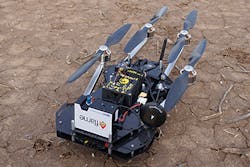Flame spectrometers quantify volcano emissions
Ocean Optics (Dunedin, FL) has sponsored a team of volcanologists on a mission to study volcanoes in the South American Andes, providing Flame miniature spectrometers and accessories. The 'Trail by Fire' project, funded by a grant from Land Rover and the Royal Geographical Society, will attempt to quantify the total amount of volatile chemical elements released by volcanoes in Chile and Peru. Ocean Optics' Flame spectrometers will be flown directly below volcanic plumes on unmanned aerial vehicles (UAVs), taking differential optical absorption spectrometry (DOAS) measurements to quantify sulphur dioxide (SO2) levels, with the goal of better understanding volcanic effects on climate.
RELATED ARTICLE: Spectrometers and spectroscopy get faster, better, cheaper
The Flames will be part of world's first mobile volcano observatory, a specially outfitted Land Rover Defender 110, reaching some of the most remote and hard to study volcanoes on earth. Faced with difficult to navigate terrain and high altitudes, the team chose TurboAce Matrix UAVs to carry the Ocean Optics spectrometers to the volcanic plumes for measurement. Using UAVs allows the researchers to get closer to the plume and collect a full cross section of measurements. This will provide higher accuracy than the ground-based measurements typically used in DOAS. The Flame's small size and low weight (265 g) were key factors in its selection, as payload weight, always an important consideration for UAVs, is especially critical at high altitude.
More importantly, despite its small size, the Flame offers the high resolution and thermal stability required for DOAS measurement, allowing the team to measure very small fluctuations in SO2 content. The spectrometers are controlled by the UAV’s onboard microprocessor, integrated with Ocean Optics’ open source SeaBreeze drivers.
Spectra collected by the Flame are saved to the UAV's onboard memory and wirelessly beamed back to the ground station. This real-time feedback will allow the team to verify operation and make measurement adjustments as the UAV is in flight. Ocean Optics says the spectrometer's modular design, with interchangeable slits to adjust resolution and throughput, will enable the team to respond quickly and easily to changing conditions in the field.
"This is truly a great application for our next generation miniature spectrometers," explains Ocean Optics product manager Henry Langston. "We love the opportunity to partner with our users, helping them take our science to new places. This is why we have a team of applications engineers on staff, to work with customers to solve challenging measurement problems. It's been so exciting to see the Trail by Fire project come together."
The Trail by Fire expedition is being funded by a nearly $46,400 grant from Land Rover, in addition to the Defender 110 donation. A number of other partners have donated equipment to the project, including Ocean Optics' sister company, Crowcon Detection Instruments. Crowcon's personal gas monitors will alert the team to any potential danger as they collect samples of toxic volcanic gases.
SOURCE: Halma;http://halmapr.com/news/oceanoptics/2015/10/12/flame-lives-up-to-its-name-joins-trail-by-fire-expedition/

Gail Overton | Senior Editor (2004-2020)
Gail has more than 30 years of engineering, marketing, product management, and editorial experience in the photonics and optical communications industry. Before joining the staff at Laser Focus World in 2004, she held many product management and product marketing roles in the fiber-optics industry, most notably at Hughes (El Segundo, CA), GTE Labs (Waltham, MA), Corning (Corning, NY), Photon Kinetics (Beaverton, OR), and Newport Corporation (Irvine, CA). During her marketing career, Gail published articles in WDM Solutions and Sensors magazine and traveled internationally to conduct product and sales training. Gail received her BS degree in physics, with an emphasis in optics, from San Diego State University in San Diego, CA in May 1986.
